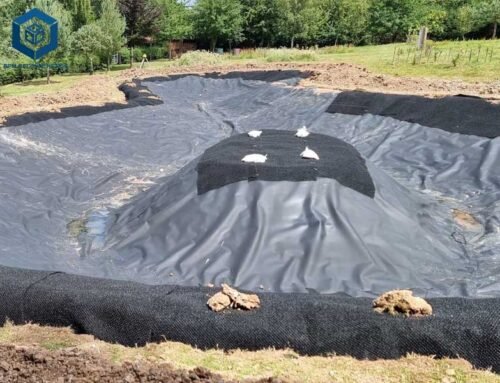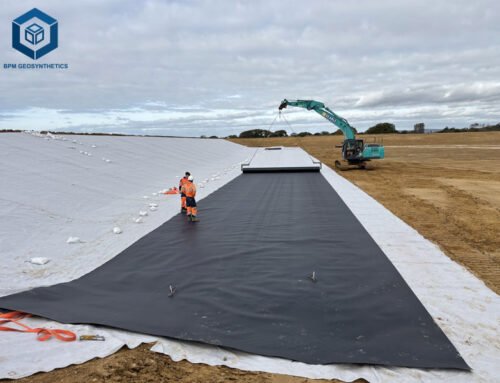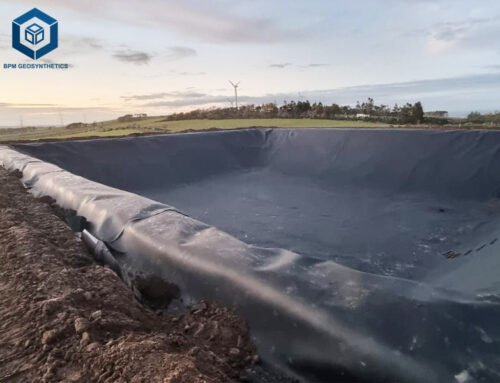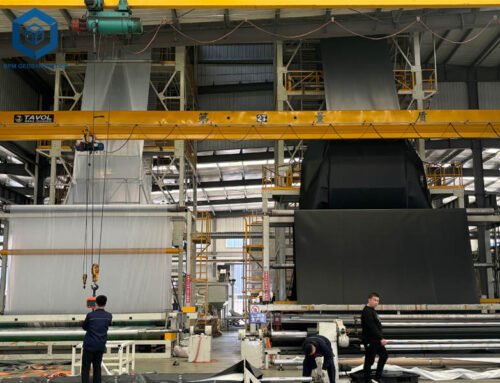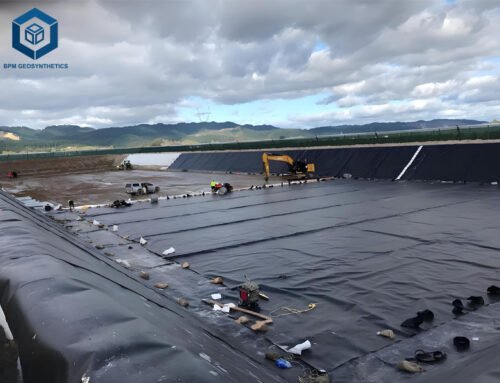Creating a pond, whether for ornamental beauty, ecological balance, or commercial purposes, demands careful material selection to ensure water retention, durability, and environmental safety. Among the array of pond liners available, EPDM (Ethylene Propylene Diene Monomer) pond liners are a leading choice due to their flexibility, longevity, and fish-safe properties. This comprehensive guide explores what BPM Geomembrane EPDM pond liners are, their specifications, benefits, installation process, applications, and key considerations for selection. Backed by industry data and expert insights, this article provides valuable knowledge to help you build a thriving pond ecosystem that lasts for decades.
1. Why You Need an EPDM Pond Liner
A pond liner is the foundation of any successful pond, acting as a waterproof barrier to prevent water seepage into the surrounding soil. For ponds hosting sensitive species like koi or supporting aquatic plants, the liner must be non-toxic, durable, and adaptable to various designs. EPDM pond liners excel in these areas, offering:
- Water Conservation: EPDM liners reduce water loss by up to 90%, saving $100–$500 annually in refilling costs for a 10×15 ft pond, based on average U.S. water rates.
- Fish and Plant Safety: Certified fish-safe under NSF-61 standards, EPDM ensures no harmful chemical leaching, critical for koi, which can grow to 3 feet and require stable water chemistry.
- Structural Integrity: EPDM resists root intrusion and soil erosion, extending pond lifespans to 20–50 years with proper maintenance.
- Design Flexibility: With 300% elasticity, EPDM conforms to irregular shapes, reducing installation time by 20–30% compared to rigid liners like HDPE.
According to a 2024 market analysis by Western Environmental Liner, EPDM liners hold a 40% share of the pond liner market, reflecting their widespread adoption in residential and commercial projects.
2. What Is an EPDM Pond Liner?
An EPDM pond liner is a synthetic rubber membrane composed of ethylene, propylene, and a diene comonomer, engineered for waterproofing and environmental resilience. Originally developed for roofing, EPDM’s exceptional flexibility, UV resistance, and chemical stability have made it a staple in pond construction. Unlike PVC or HDPE liners, EPDM is highly elastic, fish-safe, and capable of withstanding extreme weather, making it ideal for koi ponds, water gardens, and large-scale water features.
2.1 Key Characteristics of EPDM Pond Liners
- Composition: Synthetic rubber with a density of 1.15–1.20 g/cm³, balancing flexibility and strength.
- Thickness: Standard 45 mil (0.045 inches) for most ponds, with 60 mil options for high-stress environments like commercial installations.
- Elasticity: Stretches up to 300%, conforming to complex pond contours without tearing.
- UV and Chemical Resistance: Withstands prolonged sun exposure and soil chemicals, maintaining integrity for 20–50 years.
- Temperature Range: Performs in -40°C to 80°C, suitable for freeze-thaw climates.
2.2 EPDM vs. Other Pond Liners
To highlight EPDM’s advantages, here’s a comparison with other common liners:
- RPE (Reinforced Polyethylene): Lighter (0.5–1 kg/m²) and more puncture-resistant (2–3x EPDM), but less flexible and costlier per square foot ($0.40–$0.90 vs. $0.75–$2.00).
- PVC (Polyvinyl Chloride): Budget-friendly ($0.50–$1.50/sq ft) but less durable (10–15 years) and prone to UV degradation unless covered.
- HDPE (High-Density Polyethylene): Rigid, durable, and affordable ($0.60–$1.20/sq ft), but less elastic and susceptible to cracking in cold climates.
- Preformed Liners: Rigid HDPE or fiberglass shells for small ponds (9–2,150 gallons), but limited to 18–24 inches in depth, unsuitable for koi ponds requiring 4–6 ft depths.
EPDM’s combination of flexibility, durability, and fish safety makes it the preferred choice for most pond applications, especially for koi enthusiasts and professional landscapers.
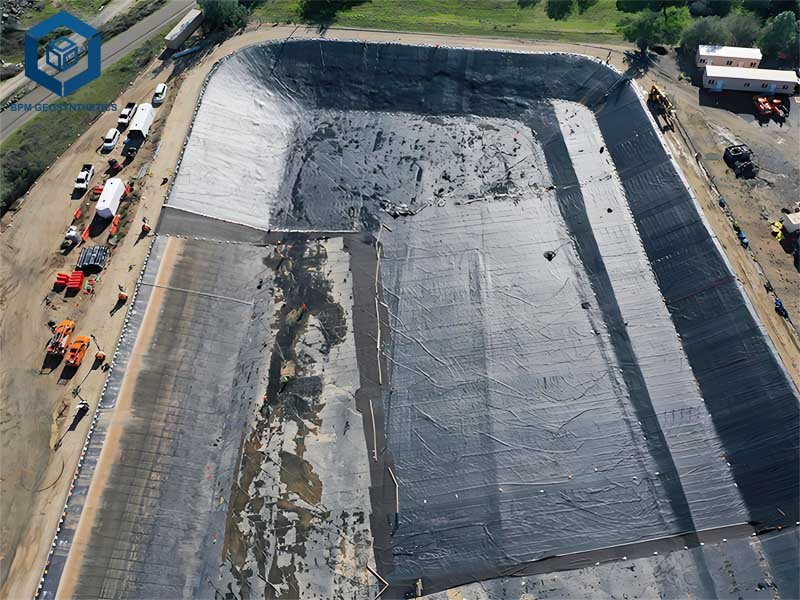
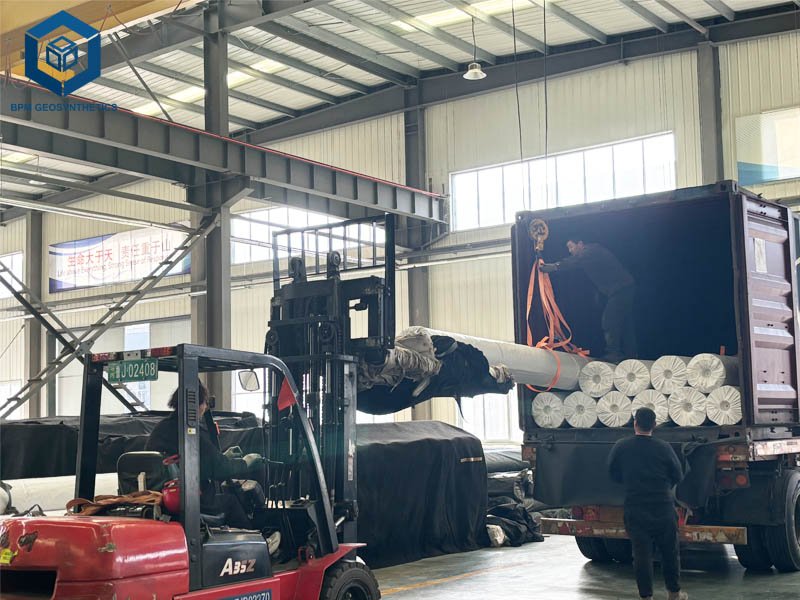
3. Key Specifications of EPDM Pond Liners
Selecting an EPDM liner requires understanding its technical specifications to ensure compatibility with your pond’s design and environmental conditions. Below is a detailed comparison of EPDM and other liners, based on data from manufacturers like Firestone PondGard and BTL Liners.
| Parameter | EPDM | RPE | PVC | HDPE |
| Thickness | 45–60 mil | 30–40 mil | 20–40 mil | 30–60 mil |
| Cost ($/sq ft) | 0.75–2.00 | 0.40–0.90 | 0.50–1.50 | 0.60–1.20 |
| Lifespan (years) | 20–50 | 15–30 | 10–15 | 15–25 |
| Puncture Resistance | High | Very High | Low | High |
| UV Resistance | Excellent | Good | Poor | Moderate |
| Fish Safety | Yes (NSF-61) | Yes | Limited | Yes |
| Flexibility | Excellent | Moderate | Good | Low |
| Weight (kg/m²) | 1.2–1.5 | 0.5–1.0 | 0.8–1.2 | 0.9–1.3 |
3.1 Additional Specifications
- Roll Sizes: Available in widths of 5–50 ft and lengths up to 200 ft, with custom sizes for large ponds (e.g., 60,000 sq ft).
- Tensile Strength: 9–11 MPa, resisting tears during installation.
- Elongation: Up to 300%, allowing adaptation to uneven surfaces.
- Warranty: Manufacturers like Firestone offer 20–25-year warranties, ensuring long-term reliability.
- Certifications: NSF-61 for fish safety and ASTM D7465 for environmental durability.
4. How to Calculate the Correct EPDM Pond Liner Size
Accurate sizing is essential to ensure a watertight seal and avoid costly mistakes. EPDM liners are sold in rolls, and proper measurements account for pond dimensions and overhang for anchoring.
4.1 Step-by-Step Calculation
Measure the maximum length, width, and depth of your pond excavation in feet. Use the following formulas:
- Liner Length= Pond Length + (2 x Max Depth) + 2 (for overhang)
- Liner Width= Pond Width + (2 x Max Depth) + 2 (for overhang)
The additional 2 feet (1 foot per side) allows for anchoring with rocks or soil. For example, a pond 10 ft long, 15 ft wide, and 4 ft deep requires:
- Liner Length= 10 + (2 x 4) + 2 = 20 ft
- Liner Width= 15 + (2 x 4) + 2 = 25 ft
- Liner Size Needed: 20 ft x 25 ft (500 sq ft)
EPDM liners are typically sold in 5-foot increments, so purchase a 20 ft x 25 ft or 25 ft x 30 ft liner to ensure coverage.
4.2 Special Considerations
- Irregular Shapes: For L-shaped or kidney-shaped ponds, divide the pond into rectangles, calculate each section, and seam with a Firestone QuickSeam kit. Seams are stronger than the liner when properly applied, with a failure rate below 1%.
- Shelves and Ledges: Add 1–2 ft for plant shelves or shallow areas, increasing liner size by 10–15%.
- Underlayment: Use a non-woven polypropylene underlayment (10 ft wide, $0.50–$1.00/sq ft) to protect against punctures. For a 500 sq ft liner, calculate: 500 / 10 = 50 ft (10 ft x 50 ft underlayment).
- Pre-Measurement Tip: Complete excavation before ordering, as bespoke-cut liners are non-returnable.
5. Installing Your EPDM Pond Liner
Proper installation ensures the EPDM liner performs effectively and lasts for decades. Below is a step-by-step guide, adapted from World of Water’s best practices.
Step 1: Plan Your Pond
Choose a site with partial shade to control algae growth and ensure access to electricity for pumps and filters. Koi ponds require 4–6 ft depths and steep sides to maximize water volume (1,500–10,000 gallons) and deter predators like herons. A 10×15 ft pond with 4 ft depth holds approximately 4,500 gallons, suitable for 10–15 koi (1 koi per sq ft surface area).
Step 2: Excavate the Pond
Dig to your desired dimensions, removing sharp rocks and roots. Use a mini-digger for large ponds to save 20–30% in labor time. Add shelves (1–2 ft deep) for plants or rocks, sloping inward to prevent predator access. For ponds over 10 ft, install a 10 cm deep, 15–20 cm wide concrete collar to anchor the liner and prevent runoff, costing $100–$300.
Step 3: Prepare the Base
Lay a 2–3 inch sand layer for a smooth surface, followed by a non-woven polypropylene underlayment to prevent punctures. Ensure the underlayment is chemical-free to protect fish. Cost: $50–$150 for a 500 sq ft pond.
Step 4: Install the Liner
Unroll the EPDM liner, centering it over the pond. Smooth out wrinkles to minimize debris buildup, which can increase disease risks by 10–15%. Secure edges with rocks, soil, or a concrete collar, leaving 1 ft of overhang. Cover exposed liner above the waterline with gravel or rocks to protect against UV damage, extending lifespan by 5–10 years.
Step 5: Install Equipment
Add a bottom drain, pump, and filtration system (gravity-fed with settling chamber, mechanical, and biological filters) to maintain water quality. Koi produce significant waste, requiring a pump with 1,000–2,000 GPH for a 4,500-gallon pond. Cost: $200–$1,000.
Step 6: Fill and Acclimatize
Fill the pond with water, checking for leaks over 24–48 hours. Wait one week for water chemistry to stabilize before adding koi. Acclimatize fish by floating their transport bag for 30 minutes, gradually adding pond water over an hour to adjust temperature and pH.
6. Applications of EPDM Pond Liners
EPDM’s versatility supports a wide range of pond applications, from small residential projects to large commercial installations. Below are key uses, supported by real-world examples.
- Koi Ponds: EPDM’s fish-safe properties and flexibility make it ideal for koi ponds (1,500–25,000 gallons). A 2024 California project used a 20×30 ft Firestone EPDM liner for a 10,000-gallon koi pond, supporting 50 koi with zero chemical leaching, costing $900 with a 25-year warranty.
- Water Gardens: EPDM accommodates irregular shapes and plant shelves, enhancing aesthetics. A UK water garden installed a 15×20 ft EPDM liner for a 3,000-gallon pond with lilies, costing $600.
- Commercial Ponds: Large-scale EPDM liners (up to 60,000 sq ft) are used in parks and resorts. A Singapore resort used a 50×100 ft EPDM liner for a 50,000-gallon ornamental pond, saving $2,000 annually in water costs.
- Streams and Waterfalls: Narrow EPDM rolls (5–10 ft wide) create flowing water features, improving oxygenation. A 10 ft wide x 50 ft long EPDM strip was used for a backyard waterfall, costing $400.
- Rainwater Reservoirs: EPDM liners store water for irrigation, with UV resistance ensuring 20–30 years of use. A 2023 Australian project used a 30×40 ft EPDM liner for a 20,000-gallon reservoir, reducing irrigation costs by 15%.
7. Advantages of EPDM Pond Liners
- Longevity: 20–50-year lifespan, outlasting PVC (10–15 years) and HDPE (15–25 years).
- Flexibility: 300% elongation adapts to complex shapes, reducing installation time by 20–30%.
- Fish Safety: NSF-61 certification ensures no harm to koi or plants, critical for sensitive ecosystems.
- UV Resistance: Withstands prolonged sun exposure, reducing degradation by 80% compared to PVC.
- Low Maintenance: Smooth surfaces minimize debris buildup, saving $50–$200 annually in cleaning costs.
- Freeze-Thaw Resilience: Performs in -40°C to 80°C, with a 5–10% lower failure rate than HDPE in cold climates.
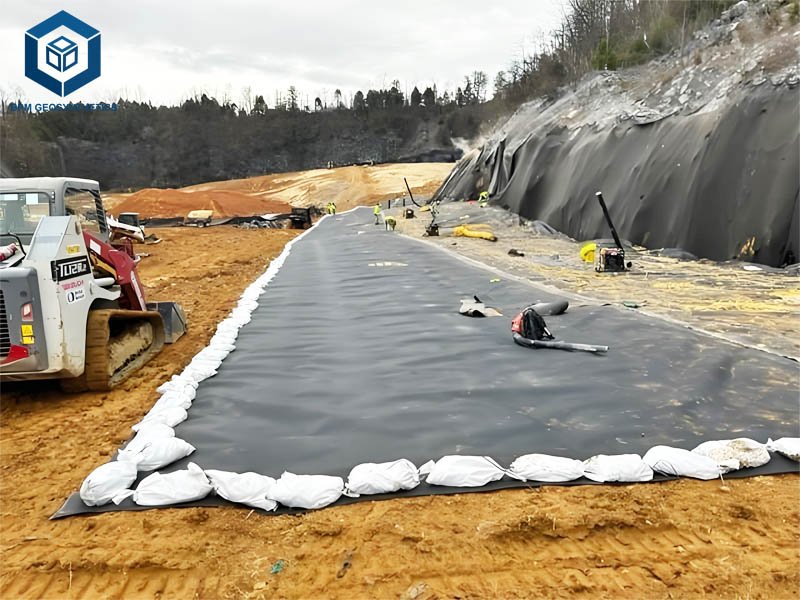
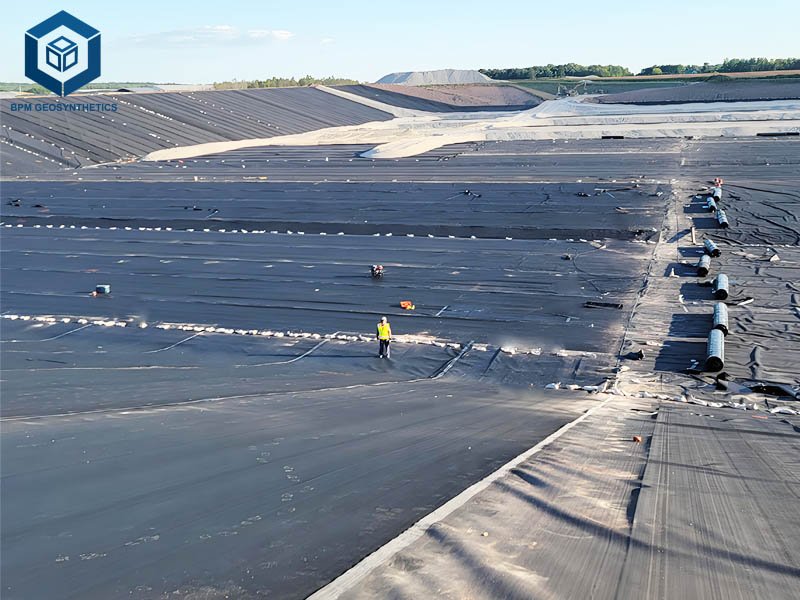
8. Disadvantages of EPDM Pond Liners
- Higher Cost: $0.75–$2.00/sq ft is more expensive than RPE ($0.40–$0.90) or PVC ($0.50–$1.50).
- Weight: At 1.2–1.5 kg/m², EPDM is heavier than RPE (0.5–1.0 kg/m²), increasing shipping costs by $50–$150 for a 500 sq ft liner.
- Installation Complexity: Requires careful smoothing to avoid wrinkles, adding 1–2 hours compared to preformed liners.
- Puncture Risk: Less puncture-resistant than RPE, requiring underlayment to prevent damage from sharp rocks (additional $50–$150).
9. Key Considerations When Choosing an EPDM Pond Liner
- Pond Size and Depth: Ensure 4–6 ft depth for koi ponds; calculate liner size accurately using the formula above.
- Material Quality: Choose NSF-61 certified EPDM (e.g., Firestone PondGard) for fish safety and durability.
- Climate: EPDM is ideal for freeze-thaw regions; avoid PVC in cold climates due to cracking risks.
- Budget: Balance upfront costs ($0.75–$2.00/sq ft) with long-term savings (20–50 years lifespan).
- Supplier Reliability: Select reputable brands like Firestone or BTL Liners, offering 20–25-year warranties.
- Underlayment: Invest in non-woven polypropylene underlayment to extend liner life by 5–10 years.
10. Final Thoughts
EPDM pond liners are a premier choice for creating durable, fish-safe, and aesthetically pleasing ponds. Their flexibility, UV resistance, and long lifespan (20–50 years) make them ideal for koi ponds, water gardens, commercial features, and more. While their higher cost and installation complexity may pose challenges, the benefits—water conservation, fish safety, and low maintenance—outweigh the drawbacks for most projects. By accurately calculating liner size, using underlayment, and following proper installation steps, you can ensure a watertight, long-lasting pond. For large or complex projects, consult a pond professional to optimize your design and enjoy a thriving aquatic ecosystem for decades.
Any questions or inquiries, please contact BPM Geosynthetics.

